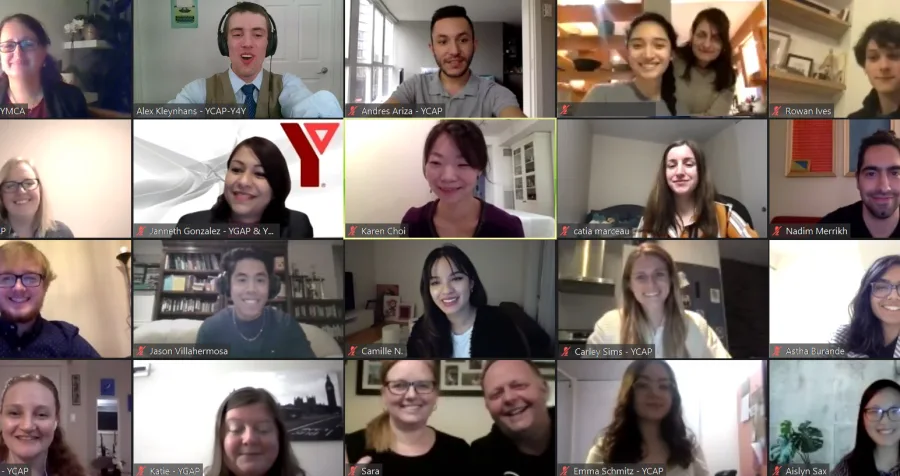Youth use digital media to shine a light on how cannabis use impacts youth brain development

On March 18, 2021 we rolled out the virtual red carpet to celebrate the people who created the top five submissions for our first annual YMCA YCAP-Y4Y Digital Media Contest. The contest challenged youth across Canada between the ages of 18 – 24 to create a poster and/or a video that described the effects cannabis can have on youth brain development.
The contest was funded by Health Canada and sought to discuss cannabis use in a neutral way. This means that each submission revealed the findings of cannabis research rather than presenting a positive or negative stance on the substance.
During the ceremony, Jason Villahermosa was awarded the top prize for his video, and Holly Webb received first place for her poster.
Here’s what our winners had to say about the contest:
First-place video: How cannabis use can affect the release of dopamine in the youth brain
Jason Villahermosa walked away from the Awards Ceremony with the first place trophy in the contest’s video stream. The video he created took an evidence-based and neutral approach to describing how cannabis use by those under the age of 25 can affect how their brain releases dopamine. Specifically, he outlined how cannabis use causes an artificial release of dopamine in the brain, which has the potential to affect how a youth’s brain will interact with dopamine long-term.
Jason’s video takes a harm-reductive approach to this look at cannabis and directs viewers to the YMCA of Greater Toronto’s Youth Cannabis Awareness Program if they’re interested in learning more about the program or accessing one of its many educational resources.

As someone with a passion for videography, Jason has always had a talent for creating impactful visuals. Throughout his time in university he used this talent to work as a videographer. And after graduation, he’s taken his talents to the field of marketing where he has found great success.
He was drawn to the contest because he felt that it would both put his filmmaking skills to the test and allow him to use his talents to have a positive impact on his community.
I wanted to try to challenge myself, and the contest seemed like the place to do that. I learned a lot from the whole process of filming, voicing, and doing research for the video. In the end, I learned a lot from this whole contest. — Jason Villahermosa
Check out Jason’s video here.
To learn more about the contest principles that informed the creation of Jason's video please refer to the section below entitled 'Principles and Method.
First-place poster: The potential long-term effects of youth cannabis use
Holly Webb won top prize for her poster that smartly uses striking visuals and an infographic format to explain -- in a neutral and evidence-supported manner -- the potential long-term impacts cannabis use can have on the brain development of those under the age of 25.
Holly’s poster notes that youth cannabis use can have a long-term impact on a person’s behaviour, the ways in which they seek pleasure, and their potential to develop a dependency. In addition to addressing these topics, her poster takes a harm-reductive approach to cannabis by offering strategies to help those who choose to consume cannabis.
As a marketing graduate with a penchant for graphic design, Holly was excited to participate in the contest. She felt it was a great opportunity to refine her design skills, while raising awareness of an increasingly important issue among youth.

When I saw this contest, I thought it was a great opportunity to pursue my passion, develop my skills and, ultimately, create a powerful message for tweens, teens and young adults. I’m so happy that I made it this far, as I have learned so much from the information provided for this contest as well as learning new skills [using software] like Adobe. — Holly Webb
Check out Holly’s poster here.
To learn more about the contest principles that informed the creation of Holly's poster please refer to the section below entitled 'Principles and Method
Register for the next round of the contest
Use your creativity to help start a discussion about youth cannabis use! We’ll let you know when registration opens for the next round of our YCAP-Y4Y Digital Media Contest on our website.
YCAP-Y4Y – Principles and Methods
Introduction
Holly, Jason and all of the contest’s participants worked with a strict set of rules and guidelines provided by YCAP-Y4Y’s parent program the Youth Cannabis Awareness Program (YCAP). The purpose of these guidelines were to ensure that every contestant’s submission contained messaging that was accurate and in line with the Youth Cannabis Awareness Program’s approach to cannabis.
Featured below are five facts about the principals and practices that informed each submission the contestants created for the contest.
Fact 1
The Youth Cannabis Awareness Program (YCAP) approaches its discussion of cannabis with a neutral and balanced perspective. This means that the program is not in the business of telling anyone whether cannabis is good or bad. Rather, it provides youth with the most up-to-date and scientifically accurate information available.
- Being a part of YCAP, the contest (YCAP-Y4Y) is also committed to being neutral.
- YCAP-Y4Y is funded by Health Canada and challenges Canadian youth (18 – 24) to explore the potential risks of cannabis use by those under the age of 25 and its potential effects on brain development.
- Every submission received for the contest was informed by the latest scientific research regarding the effects of cannabis on youth brain development.
- In order for a submission to be deemed eligible for the contest, it first had to be reviewed by the Contest Organizer.
- The Contest Organizer disqualified any submissions that featured claims that weren’t based in scientific fact or were deemed not to be neutral.
Fact 2
The YCAP-Y4Y contest is focused on the potential risks of heavy and regular recreational cannabis use, and how that usage affects youth brain development.
- Since our brains continue to develop until the age of 25, cannabis use by anyone older falls outside the scope of the contest’s discussion.
- The contest only covers recreational cannabis use. It does not address cannabis used for medicinal, cultural, or other purposes.
- All of the submissions received for the contest are based on one of four topics.
- The impact cannabis use can have on youth brain development.
- The impact cannabis use can have on dopamine in the youth brain.
- The impact cannabis use can have on the brain pruning and myelination.
- The impact cannabis use can have on the youth brain as it relates to coping mechanisms.
- As seen above, each of the contest’s topics is narrowly focused on how cannabis affects youth brain development.
- Submissions received for the contest with topics that were deemed unrelated to the impact cannabis can have on youth brain development were disqualified.
Fact 3
Cannabis is the second most used substance by Canadians under the age of 25.
- According to two of Canada’s most prominent substance use surveys (CTADS 2017 & CSTADS 2018 – 2019) cannabis is the second most used substance by those under the age of 25.
- The CTADS found that approximately 33 percent of 20–24 year olds and 19 per cent of 15–19 year olds have used cannabis in the last year.
- When compared with alcohol the usage rate of cannabis is substantially lower, with approximately 83 per cent of 20–24 year olds and 53 per cent of 15–19 year olds having used alcohol in the last year.
- When compared with tobacco, the usage rate of cannabis is significantly higher, with approximately 21 per cent of 20–24 year olds and 9 per cent of 15–19 year olds having used tobacco in the last year.
- Because cannabis use among youth is comparable to the consumption of alcohol and tobacco, it’s important to have open, honest dialogue with youth about cannabis.
- For those interesting the YMCA of Greater Toronto’s awareness initiatives regarding substances such as tobacco and alcohol please visit YSAP’s website: https://ymcagta.org/youth-programs/ysap
Sources:
Fact 4
The THC levels of recreational consumed today are on average four to five times higher than the THC levels of cannabis consumed in the 20th century.
- Since cannabis started being consumed recreationally in North America, its potency has incrementally increased.
- According to a comprehensive study performed in the United States, the average THC level for recreational cannabis was approximately 4 per cent in 1995. By 2014 the average THC level had increased to 12 per cent.
- A study released in 2021 found that the average THC levels found in recreational cannabis products increased from 9.75 per cent to 14.88 per cent in the last 10 years.
- Studies conducted within Canada have found that the average THC level of recreational cannabis products may be even higher with some studies placing the average levels between 15 per cent and 17 per cent.
- Technological advancements have allowed cannabis companies to create cannabis strains with higher potency. For example, in 2017 the Godfather OG strain was evaluated to have a THC level of 34 per cent.
Sources:
Fact 5
Recreational cannabis use can impact the brain development of those under the age of 25.
- Research has found that recreational cannabis use by those under the age of 25 can affect brain development in the following ways:
- The way in which the brain releases dopamine.
- The brain processes of pruning and myelination can be affected.
- Cannabis use might also impact a youth’s ability to learn healthy coping skills, and the ability to handle stressful situations.
- In contrast, these same studies have found that cannabis use by those over the age of 25 may not have a significant long-term impact on their brain health.
- Problems with academic progress - Students that use cannabis at least once per month are four times more likely to skip class, two to four times less likely to complete homework and about half as likely to achieve high grades.
- Source: 2017 COMPASS study supported by a grant from the Canadian Institutes of Health Research and published in the Journal of School Health
- Hospitalization – In 2017-2018, cannabis use was documented in 40 per cent of hospitalizations of youth ages 10-24, a rate higher than any other substance. Psychotic disorders were the most common conditions related to cannabis use among hospitalizations.
- Legal consequences – Youth ages 12-17 who buy, sell or possess cannabis under the legal age in their province can be charged under the Youth Criminal Justice Act. These charges can include a fine and a criminal record.
- All federal laws related to cannabis are outlined in The Cannabis Act.
- Each province has a different set of laws related to cannabis. Be sure to research the laws in your region before buying, selling or possessing cannabis.
- Impaired driving – A 2017 CCSA report noted that cannabinoids are among the most common psychoactive substances found in dead and injured drivers in Canada. Further, the report stated that while 16-34 year olds represent 32 per cent of the Canadian population, they represent 61 per cent of cannabis-attributed fatalities.
- Difficulty with relationships (conflicts at home, school, or work) – Ongoing substance use can cause issues with relationships with peers, family, friends and partners. A 2017 report on youth perceptions of cannabis found that youth reported increased conflict with romantic partners, family or friends regarding cannabis use.
- Physical health harms - Cannabis smoke can contain various carcinogens and chemicals including heavy metals, hydrogen cyanide and ammonia which can harm tissues in the lungs. A 2020 CCSA report attributed cannabis smoke to chronic bronchitis, coughing/wheezing and a feeling of tightness in the chest.
- Mental health problems - Consuming cannabis as a teenager can induce psychotic disorders within the span of a few years. In cases where teenagers begin to use cannabis between 12-14 years of age, onset of psychotic disorders begin slightly earlier. One per cent of the adult population will develop schizophrenia, but adolescents that use cannabis show twice the risk of developing this condition. Rates of cannabis use are also two to four times higher among people with schizophrenia than with the general population. (Provincial System Support Program, January 2019. “Cannabis & Psychosis: Who is at risk?”
- Dependence – One in six cannabis users who begin consuming cannabis during adolescence will meet criteria for a cannabis use disorder in their lifetime (Canadian Pediatric Society, 2017).
Source:










